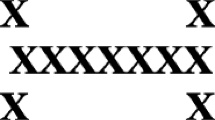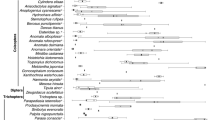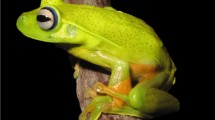Abstract
Our study aims to describe (1) external morphology of the compound eye of Antilochus conquebertii, (2) postembryonic changes involving the eye’s shape and size and (3) behaviour of the animal with respect to the organization of the compound eye. With each moult of the insect, the structural units of the compound eye increase in size as well as the number, resulting in an overall increase in eye size. The resolution of the adult eye is better than the young one. The adult possesses UV and polarization sensitivity in its eye. Parallel to the changes of the eye the behaviour of the adult animal changes, rendering it increasingly nocturnal and less active in under illuminated conditions. The current study describes the eye and its functional relationship with the behaviour of the animal at the nymphal and adult developmental stage.
Graphical abstract









Similar content being viewed by others
References
Aldrich JR, Lusby WR, Kochansky JP, Abrams CB (1984) Volatile compounds from the predatory insect Podisus maculiventris (Hemiptera: Pentatomidae). J Chem Ecol 10:561–568
Alfsnes K, Leinaas HP, Hessen DO (2017) Genome size in arthropods; different roles of phylogeny, habitat and life history in insects and crustaceans. Evol Ecol 7:5939–5947
Anderson H (1978) Postembryonic development of the visual system of the locust, Schistocerca gregaria. Development 45:55–83
Arnett RH, Thomas MC, Skelley PE, Frank JH (2002) American beetles, volume II: Polyphaga: Scarabaeoidea through Curculionoidea, vol 2. CRC Press, Boca Raton
Arnqvist G (1989) Multiple mating in a water strider: mutual benefits or intersexual conflict? Anim Behav 38:749–756
Arnqvist G, Rowe L (1995) Sexual conflict and arms races between the sexes: a morphological adaptation for control of mating in a female insect. Proc R Soc Lond B 261:123–127
Baker GT, Lawrence A, Kuklinski R, Goddard J (2015) Post-embryonic development of the compound eye of bed bugs, Cimex lectularius L. (Hemiptera: Cimicidae). Proc Entomol Soc Wash 117:1–6
Bauer T, Desender K, Morwinsky T, Betz O (1998) Eye morphology reflects habitat demands in three closely related ground beetle species (Coleoptera: Carabidae). J Zool 245:467–472
Bernhard C, Ottoson D (1960) Comparative studies on dark adaptation in the compound eyes of nocturnal and diurnal Lepidoptera. J Gen Physiol 44:195–203
Bernhard C, Gemne G, Seitz G (1972) Optical properties of the compound eye. In: Fuortes MGF (ed) Physiology of photoreceptor organs. Springer, Berlin, pp 357–379
Bernstein S, Finn C (1971) Ant compound eye: size-related ommatidium differences within a single wood ant nest. Cell Mol Life Sci 27:708–710
Bonduriansky R (2001) The evolution of male mate choice in insects: a synthesis of ideas and evidence. Biol Rev 76:305–339
Briscoe AD, Chittka L (2001) The evolution of color vision in insects. Ann Rev Entomol 46:471–510
Craig CL, Ebert K (1994) Colour and pattern in predator–prey interactions: the bright body colours and patterns of a tropical orb-spinning spider attract flower-seeking prey. Funct Ecol 8:616–620
Demos SG, Alfano RR (1996) Ice detection on metal surfaces using the degree of polarisation of diffusely reflected light [aircraft wings]. Electr Lett 32(24):2254–2255
Döring TF, Spaethe J (2009) Measurements of eye size and acuity in aphids (Hemiptera: Aphididae). Entomol Gen 32:77–84
Eguchi E (1982) Retinular fine structure in compound eyes of diurnal and nocturnal sphingid moths. Cell Tissue Res 2231:29–42
Evangelin G, Horne B, Jino M (2015) Feeding behaviour of Antilochus coquebertii (Hemiptera: Pyrrhocoridae) and its systematic positioning. J Entomol Zool Stud 3:199–203
Frolov R, Immonen EV, Vähäsöyrinki M, Weckström M (2012) Postembryonic developmental changes in photoreceptors of the stick insect Carausius morosus enhance the shift to an adult nocturnal life-style. J Neurosc 32:16821–16831
Fuseini B, Kumar R (1975) Biology and immature stages of cotton stainers (Heteroptera: Pyrrhocoridae) found in Ghana. Biol J Linn Soc 7:83–111
Ghosh S, Mishra M (2018) Fine nanostructural variation in the wing pattern of a moth Chiasmia eleonora Cramer (1780). J Biosci 43:673–684
Harvey PH, Bull JJ, Pemberton M, Paxton RJ (1982) The evolution of aposematic coloration in distasteful prey: a family model. Am Nat 119:710–719
Horridge GA (1977) The compound eye of insects. Sci Am 237:108–121
Horridge GA (1978) The separation of visual axes in apposition compound eyes. Phil Trans R Soc Lond B 285:1–59
Horváth G, Kriska G, Malik P, Robertson B (2009) Polarized light pollution: a new kind of ecological photopollution. Front Ecol Environ 7:317–325
Hu G, Lim KS, Reynolds DR, Reynolds AM, Chapman JW (2016) Wind-related orientation patterns in diurnal, crepuscular and nocturnal high-altitude insect migrants. Front Behav Neur 10:32
Huang J, Wang X, Wang ZL (2007) Bio-inspired fabrication of antireflection nanostructures by replicating fly eyes. Nanotechnology 19:025602
Jander U, Jander R (2002) Allometry and resolution of bee eyes (Apoidea). Arthropod Struct Dev 30:179–193
Jang Y, An HG, Kim H, Kim KH (2013) Spectral preferences of Lycorma delicatula (Hemiptera: Fulgoridae). Entomol Res 43:115–122
Jones CE (1978) Pollinator constancy as a pre-pollination isolating mechanism between sympatric species of Cercidium. Evolution 32:189–198
Keskinen E, Meyer-Rochow VB (2004) Post-embryonic photoreceptor development and dark/light adaptation in the spittle bug Philaenus spumarius (L.) (Homoptera, Cercopidae). Arthropod Struct Dev 33:405–417
Kohno K, Buithi N (2005) Comparison of the life history strategies of three Dysdercus true bugs (Heteroptera: Pyrrhocoridae), with special reference to their seasonal host plant use. Entomol Sci 8:313–322
Kohno K, Thi NB, Fujiwara M (2004) Predation of dysdercus cingulatus (Heteroptera: Pyrrhocoridae) by the specialist predator Antilochus coqueberti (Heteroptera: Pyrrhocoridae). Appl Entomol Zool 39(4):661–667
Kolb G (1985) Ultrastructure and adaptation in the retina of Aglais urticae (Lepidoptera). Zoomorphology 105:90–98
Koski MH, Ashman TL (2014) Dissecting pollinator responses to a ubiquitous ultraviolet floral pattern in the wild. Funct Ecol 28:868–877
Kral K (2012) The functional significance of mantis peering behaviour. Eur J Entomol 109:295
Kral K, Poteser M (2009) Relationship between body size and spatial vision in the praying mantis-an ontogenetic study. Aust Orth J 18:153–158
Land MF (1997) Visual acuity in insects. Ann Rev Entomol 42:147–177
Land MF, Nilsson DE (2012) Animal eyes. Oxford University Press, Oxford
Lehmann T, Heß M, Melzer RR (2018) Sense organs in Pycnogonida: a review. Acta Zool 99:211–230
Mazokhin-Porshnyakov GA (1969) Insect vision. Plenum Press, New York
Meyer-Rochow VB, Keskinen E (2003) Post-embryonic photoreceptor development and dark/light adaptation in the stick insect Carausius morosus (Phasmida, Phasmatidae). Appl Entomol Zool 38:281–291
Meyer-Rochow VB, Mishra M (2007) Structure and putative function of dark-and light-adapted as well as UV-exposed eyes of the food store pest Psyllipsocus ramburi Sélys-longchamps (Insecta: Psocoptera: Psyllipsocidae). J Insect Physiol 53:157–169
Mishra M (2013) Eye ultrastructure of three ecologically diverse elaterid beetle species (Coleoptera: Elateridae). Entomol Gen 34:235–247
Mishra M, Meyer-Rochow VB (2006a) Fine structure of the compound eye of the fungus beetle Neotriplax lewisi (Coleoptera, Cucujiformia, Erotylidae). Inver Biol 125:265–278
Mishra M, Meyer-Rochow VB (2006b) Eye ultrastructure in the pollen-feeding beetle, Xanthochroa luteipennis (Coleoptera: Cucujiformia: Oedemeridae). Microscopy 55:289–300
Moser JC, Reeve JD, Bento JMS, Della Lucia TM, Cameron RS, Heck NM (2004) Eye size and behaviour of day-and night-flying leafcutting ant alates. J Zool 264:69–75
Muir LE, Kay BH, Thorne MJ (1992) Aedes aegypti (Diptera: Culicidae) vision: response to stimuli from the optical environment. J Med Entomol 29:445–450
Narendra A, Ribi WA (2017) Ocellar structure is driven by the mode of locomotion and activity time in Myrmecia ants. J Exp Biol 220:4383–4390
Narendra A, Alkaladi A, Raderschall CA, Robson SK, Ribi WA (2013a) Compound eye adaptations for diurnal and nocturnal lifestyle in the intertidal ant, Polyrhachis sokolova. PLoS One 8:e76015
Narendra A, Alkaladi A, Raderschall CA, Robson SK, Ribi WA (2013b) Correction: compound eye adaptations for diurnal and nocturnal lifestyle in the intertidal ant, Polyrhachis sokolova. PLoS One 8(10):1371
Nilsson DE (1989) Optics and evolution of the compound eye. In: Stavenga DG, Hardie RC (eds) Facets of vision. Springer, Berlin, pp 30–73
Nilsson DE, Ro AI (1994) Did neural pooling for night vision lead to the evolution of neural superposition eyes? J Comp Physiol A 175:289–302
Noriega JA, Huay Lee JS (2010) Predation on Onthophagus rutilans Sharp (Coleoptera: Scarabaeidae) by Dindymus albicornis (Fabricius) (Hemiptera: Pyrrhocoridae). Bol Sea 46:609–610
O’Carroll D (1993) Feature-detecting neurons in dragonflies. Nature 362(6420):541–543
Paul R, Steiner A, Gemperlein R (1986) Spectral sensitivity of Calliphora erythrocephala and other insect species studied with Fourier Interferometric Stimulation (FIS). J Comp Physiol 158:669–680
Poulton EB (1887) An enquiry into the cause and extent of a special colour-relation between certain exposed lepidopterous pupae and the surfaces which immediately surround them. Philos Trans R Soc B 178:311–441
Rothschild M (1961) Defensive odours and mullerian mimicry among insects. Trans R Entomol Soc Lond 113:101–123
Schaefer CW (1999) Review of Raxa (Hemiptera: Pyrrhocoridae). Ann Entomol Soc Am 92:14–19
Schwermann AH, dos Santos Rolo T, Caterino MS, Bechly G, Schmied H, Baumbach T et al (2016) Preservation of three-dimensional anatomy in phosphatized fossil arthropods enriches evolutionary inference. eLife 5:e12129
Shimoda M, Honda KI (2013) Insect reactions to light and its applications to pest management. Appl Entomolo Zool 48:413–421
Snyder AW, Stavenga DG, Laughlin SB (1977) Spatial information capacity of compound eyes. J Comp Physiol 116:183–207
Staddon JE (2016) Adaptive behavior and learning. Cambridge University Press, Cambridge
Stavenga D, Stowe S, Siebke K, Zeil J, Arikawa K (2004) Butterfly wing colours: scale beads make white pierid wings brighter. Proc R Soc Biol Sci 271:1577–1584
Stavenga D, Foletti S, Palasantzas G, Arikawa K (2006) Light on the moth-eye corneal nipple array of butterflies. Proc R Soc Biol Sci 273:661–667
Stehlík JL, Jindra Z (2006) New species of Largidae and Pyrrhocoridae (Heteroptera) from the Oriental region. Acta Entomol Mus Nat Prag 46:31–41
Tyrer N, Bacon J, Davies C (1979) Sensory projections from the wind-sensitive head hairs of the locust Schistocerca gregaria. Cell Tissue Res 203:79–92
Warrant EJ (2001) The design of compound eyes and the illumination of natural habitats. In: Barth FG, Schmid A (eds) Ecology of sensing. Springer, Berlin, pp 187–213
Warrant E, Dacke M (2016) Visual navigation in nocturnal insects. Physiology 31:182–192
Yilmaz A, Aksoy V, Camlitepe Y, Giurfa M (2014) Eye structure, activity rhythms, and visually-driven behavior are tuned to visual niche in ants. Front Behav Neur 8:205
Young DK (1973) A revision of the family Pyrochroidae (Coleoptera: Heteromera) for North America based on the larvae, pupae and adults. In: American Entomological Institute. Contributions, American Entomological Institute
Zack S, Bacon J (1981) Interommatidial sensilla of the praying mantis: their central neural projections and role in head-cleaning behavior. Dev Neurobiol 12:55–65
Zhang H (2010) Latin square design. In: Salkind N (ed) Encyclopedia of research design. SAGE Publications Inc., Thousand Oaks, pp 99–704
Zhang W, Zhang D, Fan T, Gu J, Ding J, Wang H et al (2008) Novel photoanode structure templated from butterfly wing scales. Chem Mater 21:33–40
Acknowledgements
We wish to thank the technician of the scanning electron microscopy facility of National Institute of Technology, Rourkela, for handling the electron microscope. Shaunak, Sayantan and Tryanti are acknowledged for their help in catching the insects and helping Ishita while doing the behavioural analysis. Dr. Harekrushna Sahoo is thankfully acknowledged for the statistical analysis and Dr. Binod Bihari Sahu is thankfully acknowledged for identifying the scientific names of the flowers used in this study. Anonymous reviewers are thankfully acknowledged for their valuable comments which help to improve the manuscript.
Author information
Authors and Affiliations
Corresponding author
Ethics declarations
Conflict of interest
The authors declare that they have no conflict of interest for this manuscript.
Additional information
Publisher's Note
Springer Nature remains neutral with regard to jurisdictional claims in published maps and institutional affiliations.
Rights and permissions
About this article
Cite this article
Mishra, M., Chakraborty, I. & Basu, S. A study of the role of vision in the foraging behaviour of the pyrrhocorid bug Antilochus conquebertii (Insecta; Hemiptera; Pyrrhocoridae). Invert Neurosci 19, 2 (2019). https://doi.org/10.1007/s10158-018-0222-6
Received:
Accepted:
Published:
DOI: https://doi.org/10.1007/s10158-018-0222-6




